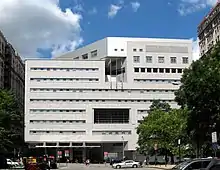New York Family Court
The Family Court of the State of New York is a specialized court of the New York State Unified Court System located in each county of the state.[2][3][4] The New York City Family Court is the name given to the state Family Court within New York City.
| Court overview | |
|---|---|
| Formed | September 1, 1962 |
| Jurisdiction | New York |
| Court executive |
|
| Parent department | New York State Unified Court System |
| Key document | |
Jurisdiction
It is a family court that hears cases involving children and families and handles issues such as child abuse and neglect (child protection), adoption, child custody and visitation, domestic violence, guardianship, juvenile delinquency, paternity, persons in need of supervision (PINS), and child support.[5] In New York City, it has concurrent jurisdiction with the New York City Criminal Court for family offenses (domestic violence).

Family Court does not have jurisdiction over divorces, which must be litigated in the Supreme Court, and although Criminal Court domestic violence parts typically hear all cases involving crimes against intimate partners (whether opposite- or same-sex), New York law defines family offenses to include only those related by blood, actual marriage (common law marriage is not recognized in New York), or a child in common.
Judges
In the New York City Family Court (the "Family Court of the State of New York within the City of New York"), judges are appointed by the Mayor to ten-year terms; elsewhere they are elected to ten-year terms.[2] There are 47 judges in the New York City Family Court.[6]
In 1939, Justice Jane Bolin became the first black female judge in the United States when Mayor Fiorello La Guardia swore her in to the bench of the Family Court, then called the Domestic Relations Court. Her 10-year appointment was renewed by the city's mayors three times until she reached the mandatory retirement age of 70.
History
| Part of a series on |
| New York State Unified Court System |
|---|
|
|
Specialized |
The children's court part of the New York City court of special sessions was created in 1915, from a 1902 children's court division of the New York County court of general sessions.[7] Children's courts were authorized throughout the state by constitutional referendum in 1921 followed by statute in 1922.[8] The Children's Court of the City of New York was a state court that opened on September 15, 1924 and was consolidated into the Domestic Relations Court of the City of New York created on October 1, 1933.[9][10] In 1962 the Family Court replaced these courts after a 1961 constitutional amendment.[1]
See also
Notes
- "Family Court Act". Laws of New York. 1962. pp. 3043–3132. hdl:2027/uc1.b4378119. ISSN 0892-287X.
{{cite book}}:|journal=ignored (help) Chapter 686, enacted 24 April 1962, effective 1 September 1962. - Constitution of the State of New York Article VI, § 13
- Family Court Act § 113
- New York City Bar Association 2012, pp. 3–5.
- New York City Bar Association 2012, p. 1.
- Glaberson, William (March 28, 2012). "For Top Judge, Tough Lessons on Family Court Bench". The New York Times.
- "An Act to amend the inferior criminal courts act of the city of New York, generally". Laws of New York. 1915. pp. 1560–1589. hdl:2027/nyp.33433090742796. ISSN 0892-287X.
{{cite book}}:|journal=ignored (help) Chapter 531, enacted 8 May 1915. - "Children's Court Act". Laws of New York. 1922. pp. 1259–1276. hdl:2027/nyp.33433090742804. ISSN 0892-287X.
{{cite book}}:|journal=ignored (help) Chapter 547, enacted 10 April 1922, effective 1 May 1922. - "Children's Court Act of the City of New York". Laws of New York. 1924. pp. 493–514. hdl:2027/nyp.33433108121108. ISSN 0892-287X.
{{cite book}}:|journal=ignored (help) Chapter 254, enacted 23 April 1924, effective 15 September 1924. - "Domestic Relations Court Act of the City of New York". Laws of New York. 1933. pp. 1038–1080. hdl:2027/umn.31951d022825520. ISSN 0892-287X.
{{cite book}}:|journal=ignored (help) Chapter 482, enacted 26 April 1933, effective 1 October 1933.
References
- Introductory Guide to the New York City Family Court (PDF). Committee on Family Law and Family Court of the Association of the Bar of the City of New York. February 2012.
External links
- Legal Referral Service (a lawyer referral service) from the New York City Bar Association
- Lawyer Referral and Information Service (a lawyer referral service) from the New York State Bar Association
- New York City Family Court
- Family Court outside New York City
- Family Court Act as amended in the Consolidated Laws
- Domestic Relations Law as amended in the Consolidated Laws
- Social Services Law as amended in the Consolidated Laws
- Uniform Rules for the Family Court in the NYCRR